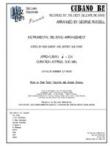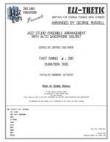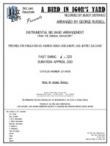BIRD IN IGOR'S YARD, A [DOWNLOAD]
Recorded by Buddy DeFranco
Arranged by George Russell, Prepared by Andrew Homzy, Rob DuBoff, and Jeffrey Sultanof

Cat #: JLP-8930-DL
$85.00This product is available for immediate download after purchase.
Questions?
Please call +1-518-587-1102 or email us.
Edition: Jazz Big Band Arrangement
Description: Swing - Advanced
Publisher: Jazz Lines Publications
In 1949, Capitol Records was actively recording modern jazz for a special 60000 series, and they were calling in some of the top musicians to make recordings. Among the artists were Miles Davis, Dave Lambert, and Lennie Tristano. In April, Buddy DeFranco fronted an all-star big band for a series of sides. One of them, often later discussed but not released at the time, was George Russell's A Bird in Igor's Yard, invoking the names of Charlie Parker and Igor Stravinsky. Despite this being a very difficult piece to play, the band did a remarkable job. Unfortunately, Capitol did not release the recording at the time.
In years to come, when Russell had achieved notoriety with his Lydian Chromatic Concept book and the recording Jazz Workshop for RCA, he would mention A Bird in Igor's Yard in interviews. This suggested that he was still proud of the composition. What it sounded like remained a mystery until a series of Capitol LPs was issued by Dutch EMI in 1972. U.S. Capitol issued the series that same year, and finally A Bird in Igor's Yard was let out of the vault and heard. This publication is based on a set of parts and a reconstructed score that George Russell worked on with an assistant. This newly created score was based on the original, which had apparently become too difficult to read. Where needed, the original 1949 recording was used as a source for clarification.
There is no getting around the fact that this is an advanced arrangement. There are many spots where sections are playing against each other with 3 vs. 4. There are polytonal harmonies, off-beat accents, meter changes, and, if that wasn't enough, a polymeter section where half the ensemble is in 3/4 and other half in 4/4! Needless to say, it will take considerable work to play this well. But, it would make a great concert or festival piece!
Clarinet
2 Alto Saxophones
2 Tenor Saxophones
Baritone Saxophone
4 Trumpets
3 Trombones
Tuba (optional)
Guitar
Piano
Bass
Drums
Trombones 1 & 2: Db5









